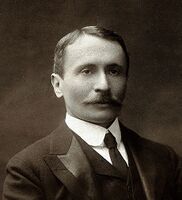Stein, A.: Difference between revisions
Stein, A.
(Created page with "{{Person |HasDrlPage=Yes |HasLibPage=Yes |HasBnwPage=Yes |pagename=Stein, A. |PersonType=Authors of English Works; Authors of Sanskrit Works; Translators |MainNamePhon=Sir Aur...") |
No edit summary |
||
| (5 intermediate revisions by the same user not shown) | |||
| Line 5: | Line 5: | ||
|pagename=Stein, A. | |pagename=Stein, A. | ||
|PersonType=Authors of English Works; Authors of Sanskrit Works; Translators | |PersonType=Authors of English Works; Authors of Sanskrit Works; Translators | ||
|images=File:Stein Aurel Wikipedia.jpg | |||
|MainNamePhon=Sir Aurel Stein | |MainNamePhon=Sir Aurel Stein | ||
|yearbirth=1862/11/26 | |||
|yeardeath=1943/10/26 | |||
|bornin=Budapest, Hungary | |||
|bio=Sir Aurel Stein, (born Nov. 26, 1862, Budapest, Hung.—died Oct. 26, 1943, Kabul, Afg.), Hungarian–British archaeologist and geographer whose travels and research in central Asia, particularly in Chinese Turkistan, revealed much about its strategic role in history.<br> Principal of the Oriental College, Lahore, Punjab, India (now in Pakistan; 1888–99), in 1892 he published his Sanskrit edition of the only known surviving ancient Indian historical work, the 12th-century ''Rājataraṅgiṇī'' by Kalhaṇa. His English translation, ''A Chronicle of the Kings of Kaśmīr'', followed in 1900.<br> In that year he began the first of his central Asian expeditions, traveling through westernmost China to Khotan. In the course of this and three other expeditions (1906–08, 1913–16, and 1930), he traced the ancient caravan routes between China and the West, made valuable geographical observations on little-known regions, and collected many documents and artifacts, from Neolithic stone tools to 8th-century-AD grave findings and textiles. Near Tun-huang he discovered the Cave of the Thousand Buddhas, unknown outside China, which, with its extraordinary assemblage of paintings, temple banners, and documents, had been walled up since the 11th century. Many of the treasures he found are in the Asian Antiquities Museum, New Delhi. The results of his work of this period were published in ''Ancient Khotan'', 2 vol. (1907), ''Serindia'', 5 vol. (1921), and ''Innermost Asia'', 4 vol. (1928).<br> Superintendent of the Indian Archaeological Survey (1910–29), Stein was also interested in Greco-Buddhist remains and in tracing Alexander the Great’s eastern campaigns. In 1926, at Pīr Sarāi, near the Indus River, he identified the site of Alexander’s storming of the nearly impregnable Rock of Aornos. Other studies by Stein added to the precise knowledge of Alexander’s movements in Asia. In an effort to elucidate the relationship between Mesopotamian and Indus civilizations, Stein investigated ancient mounds in Iran and Baluchistan. He also carried out an aerial photographic reconnaissance of the Roman frontiers in Iraq. Near his 81st birthday, his long-standing wish to explore in Afghanistan was granted, but he died there before he could commence his work. A British subject from 1904, he was knighted in 1912. ([https://www.britannica.com/biography/Aurel-Stein Source Accessed June 19, 2020]) | |||
|IsInGyatsa=No | |IsInGyatsa=No | ||
}} | }} | ||
Latest revision as of 17:56, 6 August 2020
| PersonType | Category:Authors of English Works Category:Authors of Sanskrit Works Category:Translators |
|---|---|
| MainNamePhon | Sir Aurel Stein |
| bio | Sir Aurel Stein, (born Nov. 26, 1862, Budapest, Hung.—died Oct. 26, 1943, Kabul, Afg.), Hungarian–British archaeologist and geographer whose travels and research in central Asia, particularly in Chinese Turkistan, revealed much about its strategic role in history. Principal of the Oriental College, Lahore, Punjab, India (now in Pakistan; 1888–99), in 1892 he published his Sanskrit edition of the only known surviving ancient Indian historical work, the 12th-century Rājataraṅgiṇī by Kalhaṇa. His English translation, A Chronicle of the Kings of Kaśmīr, followed in 1900. In that year he began the first of his central Asian expeditions, traveling through westernmost China to Khotan. In the course of this and three other expeditions (1906–08, 1913–16, and 1930), he traced the ancient caravan routes between China and the West, made valuable geographical observations on little-known regions, and collected many documents and artifacts, from Neolithic stone tools to 8th-century-AD grave findings and textiles. Near Tun-huang he discovered the Cave of the Thousand Buddhas, unknown outside China, which, with its extraordinary assemblage of paintings, temple banners, and documents, had been walled up since the 11th century. Many of the treasures he found are in the Asian Antiquities Museum, New Delhi. The results of his work of this period were published in Ancient Khotan, 2 vol. (1907), Serindia, 5 vol. (1921), and Innermost Asia, 4 vol. (1928). Superintendent of the Indian Archaeological Survey (1910–29), Stein was also interested in Greco-Buddhist remains and in tracing Alexander the Great’s eastern campaigns. In 1926, at Pīr Sarāi, near the Indus River, he identified the site of Alexander’s storming of the nearly impregnable Rock of Aornos. Other studies by Stein added to the precise knowledge of Alexander’s movements in Asia. In an effort to elucidate the relationship between Mesopotamian and Indus civilizations, Stein investigated ancient mounds in Iran and Baluchistan. He also carried out an aerial photographic reconnaissance of the Roman frontiers in Iraq. Near his 81st birthday, his long-standing wish to explore in Afghanistan was granted, but he died there before he could commence his work. A British subject from 1904, he was knighted in 1912. (Source Accessed June 19, 2020) |
| YearBirth | 1862/11/26 |
| YearDeath | 1943/10/26 |
| BornIn | Budapest, Hungary |
| IsInGyatsa | No |
| Other wikis |
If the page does not yet exist on the remote wiki, you can paste the tag |
